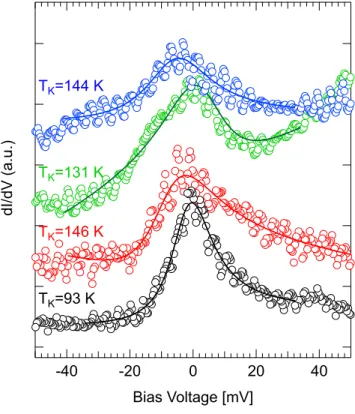Adsorption-Induced Kondo Effect in Metal-Free
Phthalocyanine on Ag(111)
J. Granet,
†M. Sicot,
∗,†I. C. Gerber,
‡G. Kremer,
†,¶T. Pierron,
†B. Kierren,
†L.
Moreau,
†Y. Fagot-Revurat,
†S. Lamare,
§F. Ch´
erioux,
§and D. Malterre
††Universit´e de Lorraine, CNRS, IJL, F-54000 Nancy, France
‡Universit´e de Toulouse, INSA-CNRS-UPS, LPCNO, 135 Avenue de Rangueil, 31077 Toulouse, France
¶D´epartement de Physique and Fribourg Center for Nanomaterials, Universit´e de Fribourg, CH-1700 Fribourg, Switzerland
§Univ. Bourgogne Franche-Comt´e, FEMTO-ST, CNRS, UFC, 15B avenue des Montboucons, F-25030 Besan¸con cedex, France
Supporting Information Available
dI /d V (a .u .) -40 -20 0 20 40 Bias Voltage [mV] TK=93 K TK=146 K TK=131 K TK=144 KFigure S1: Set of 4 STS curves acquired over 2HPc molecules in G-phase (dotted lines) along with their Fano fits (solid lines) and their corresponding extracted Kondo temperatures TK.
6x10
-34
2
0
-2
-4
dI
/d
V
(a
rb
. u
ni
ts)
-40
-20
0
20
40
Bias Voltage (mV)
TK=66 K TK=61 K TK=62 K TK=66 K TK=69 K TK=59 K TK=57 KFigure S2: Set of 7 STS curves acquired over 2HPc molecules arranged in C-phase (dot-ted lines) along with their Fano fits (solid lines) and their corresponding extrac(dot-ted Kondo temperatures TK. Set point is Vb= 1 mV, It= 200 pA. A vertical shift was added for clarity.
Γ
-8
-6
-4
-2
0
2
4
E [eV]
K
M
Γ
a
b
c
d
4
Figure S4: Pairs of STM images recorded successively (a,b) and (c,d). Tunneling current: 200 pA. Bias voltage: (a) 1 mV, (b) 7 mV,(c) −7 mV and (d) 100 mV. Green arrows point to molecules that have rotated between scans. The color scale is such that dark blue colors represent high z values. The cross in (b) corresponds to spectrum number 4 in Fig.4(a).
500 400 300 200 100 0
Ph
ot
oe
le
ct
ro
n
in
te
nsi
ty
(a
rb
. u
ni
ts)
1.5
1.0
0.5
0.0
Binding Energy (eV)
KONDO
F-LUMO
HOMO
G-phase
C-phase
Figure S5: UPS spectra recorded at T= 9 K on G and C-phases. Spectra have been shifted vertically for clarity.
20 15 10 5 0
PD
O
S
(a
rb
. u
ni
ts)
-2
-1
0
1
2
E-E
F(eV)
pz s px pyFigure S6: Computed density of states projected onto atomic orbitals of 2HPc on Ag(111) for molecules assembled in 7 × 7 arrangement.
This material is available free of charge via the Internet at http://pubs.acs.org/.
The appearance of the Kondo resonance is sensitive to the state of the tunneling tip especially after tip conditioning by dipping it into the Ag surface and/or applying bias voltage pulses. When the Kondo resonance is absent, it is so indistinctively of the probed molecule. Usually, it reappears after further tip treatments. This effect was also observed on another kind of metal-organic interface involving a phthalocyanine liguand on Ag(111) (see reference : J. Granet et al., Nanoscale 2018, 10, 9123, Figure S7 in supplementary information).





